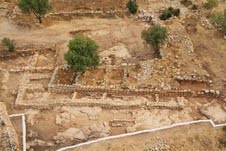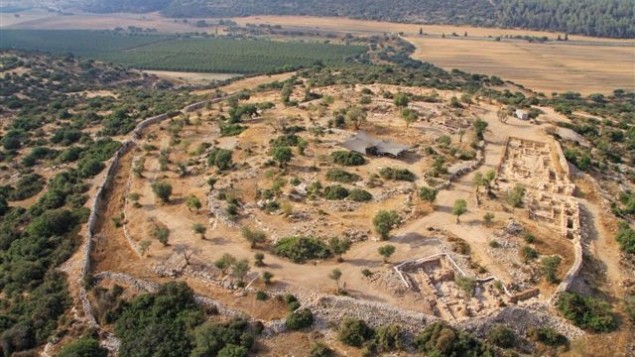Khirbet Qeiyafa, where archaeologists believe King David built his palace (photo credit: courtesy/ Israel Antiquities Authority)
Archaeologists say they’ve found
(another) one of King David’s palaces
Two large structures — one said to be monarch’s palace; the other a royal storeroom — uncovered at Khirbet Qeiyafa site near Jerusalem and dated to Davidic period.
Reprinted from: The Times of Israel, BY LAZAR BERMAN July 18, 2013, 3:58 pm
Two Israeli archaeologists announced that they have found a palace and royal storehouse that belonged to King David. The two buildings are the largest structures standing during the tenth century BCE to have been found in the territory of the Kingdom of Judah. The discovery was made at Khirbet Qeiyafa near Beit Shemesh southwest of Jerusalem, said Professor Yossi Garfinkel of the Hebrew University and Saar Ganor of the Israel Antiquities Authority on Thursday. Over the past year, the researchers uncovered the two buildings at the site, which is believed by some to be the fortified Judean city of Shaarayim. According to the biblical record, after David smote Goliath, the Philistines were slaughtered on the road to Shaarayim as they fled. Shaarayim means “two gates,” and Khirbet Qeiyafa has two gates in its walls.
The two archaeologists identified one building as David’s palace and the other as a massive royal storeroom. The excavation of the site as a whole has stretched on for seven years.
When David would visit this important regional center, “he definitely didn’t live in a simple home,” Ganor told The Times of Israel.
“Khirbet Qeiyafa is the best example exposed to date of a fortified city from the time of King David,” read a statement released by the researchers. “The southern part of a large palace that extended across an area of c. 1,000 sq m was revealed at the top of the city. The wall enclosing the palace is c. 30 m long and an impressive entrance is fixed it through which one descended to the southern gate of the city, opposite the Valley of Elah. Around the palace’s perimeter were rooms in which various installations were found – evidence of a metal industry, special pottery vessels and fragments of alabaster vessels that were imported from Egypt.”
“This is the only site in which organic material was found — including olive seeds — that can be carbon-14 dated” to the period of King David’s reign, Israel Antiquities Authority spokeswoman Yoli Schwartz told The Times of Israel.
 The
remains of what Israeli archaeologists
believe is King David’s palace at Khirbet
Qeiyafa (photo credit: Courtesy/ Israel
Antiquities Authority)
The
remains of what Israeli archaeologists
believe is King David’s palace at Khirbet
Qeiyafa (photo credit: Courtesy/ Israel
Antiquities Authority)
In addition, the location of the buildings fit the requirements of an Iron Age palace. “The palace is located in the center of the site and controls all of the houses lower than it in the city. From here one has an excellent vantage looking out into the distance, from as far as the Mediterranean Sea in the west to the Hebron Mountains and Jerusalem in the east. This is an ideal location from which to send messages by means of fire signals.”
Garfinkel and Ganor believe that the pillared building, 15 meters (49 feet) long by 6 meters wide in the north of the city, was used as a royal storeroom. “It was in this building the kingdom stored taxes it received in the form of agricultural produce collected from the residents of the different villages in the Judean Shephelah,” they said. “Hundreds of large store jars were found at the site whose handles were stamped with an official seal as was customary in the Kingdom of Judah for centuries.”
They see the finds as evidence of centralized construction and royal administrative organization during King David’s rule. “This is unequivocal evidence of a kingdom’s existence, which knew to establish administrative centers at strategic points,” they argued. “To date no palaces have been found that can clearly be ascribed to the early tenth century BCE as we can do now. Khirbet Qeiyafa was probably destroyed in one of the battles that were fought against the Philistines circa 980 BCE. The palace that is now being revealed and the fortified city that was uncovered in recent years are another tier in understanding the beginning of the Kingdom of Judah.”
In light of the find, the Israel Antiquities Authority and the Nature and Parks Authority are working with local planning bodies to cancel the impending construction of a neighborhood nearby, and hope to reserve the area around the site as a national park. In 2008, a pottery sherd with five lines of text was discovered at the site. Many scholars believe it to be early Hebrew writing, possibly referring to the ascent of King Saul to the throne. Others argue it features Israelite social rules, while some dispute the idea that it is written in Hebrew at all. The sherd currently sits in Jerusalem’s Israel Museum.
Garfinkel and Ganor believe that what remained of the palace was further damaged during the Byzantine period when a fortified farmhouse was built on the site.
Another prominent Israeli archaeologist has long claimed to have uncovered David’s Jerusalem palace, mentioned in II Samuel: “Now Hiram king of Tyre sent envoys to David, along with cedar logs and carpenters and stonemasons, and they built a palace for David.” In 2005, Eilat Mazar, granddaughter of the “dean” of biblical archaeology, Benjamin Mazar, began digging in the oldest portion of Jerusalem, the City of David. She focused on Area H, above the Stepped Stone Structure, a massive Jebusite Iron Age fortified building.
She believed that the spot on the northern edge of the City of David was a prime candidate for the site of David’s palace. II Samuel states that after David heard that the Philistines were gathering to make war against him, he “went down to the stronghold” from his palace. She decided to dig in Area H, the only part of the city higher than the fortress, from which King David would have gone down.
Her hypothesis was also supported by British archaeologist Kathleen Kenyon’s discovery of elegant masonry in the same area.
“When I told my grandfather of my idea about the possible location of David’s palace,” Mazar wrote in Biblical Archaeology Review, “he was enthusiastic about it. ‘Where, exactly,’ he asked me, ‘did Kenyon find the piles of ashlars [nicely hewn rectangular stones] together with the proto-Aeolic (sometimes called proto-Ionic) capital? Wasn’t it right next to the place you’re talking about?’ Indeed, it was. When I ran to check Kenyon’s reports, I confirmed that ashlar stones and an elegant proto-Aeolic capital had been found literally at the foot of the scarp at the southeastern edge of the structure in Area H. And this was just the kind of impressive remains that one would expect to come from a tenth-century B.C.E. king’s palace.”
Mazar found a massive public building there that she called the Large Stone Structure. In addition to Kenyon’s earlier discoveries there, Mazar uncovered pottery sherds from the very end of the Iron Age I period, about 1000 BCE, when David is believed to have captured Jerusalem. However, Mazar’s conclusion is controversial. Archaeologists from Tel Aviv University contend that her overly literal reading of the biblical text skews her analysis of the archaeological record.











 Our Midrash Marathon Madness Contest
winner for the fourth week of this Biblical 7th month, is announced in this newsletter, above.
Thank Tsiyon Road listeners, for all of your great entries! All of
our weekly wining entries are posted
Our Midrash Marathon Madness Contest
winner for the fourth week of this Biblical 7th month, is announced in this newsletter, above.
Thank Tsiyon Road listeners, for all of your great entries! All of
our weekly wining entries are posted